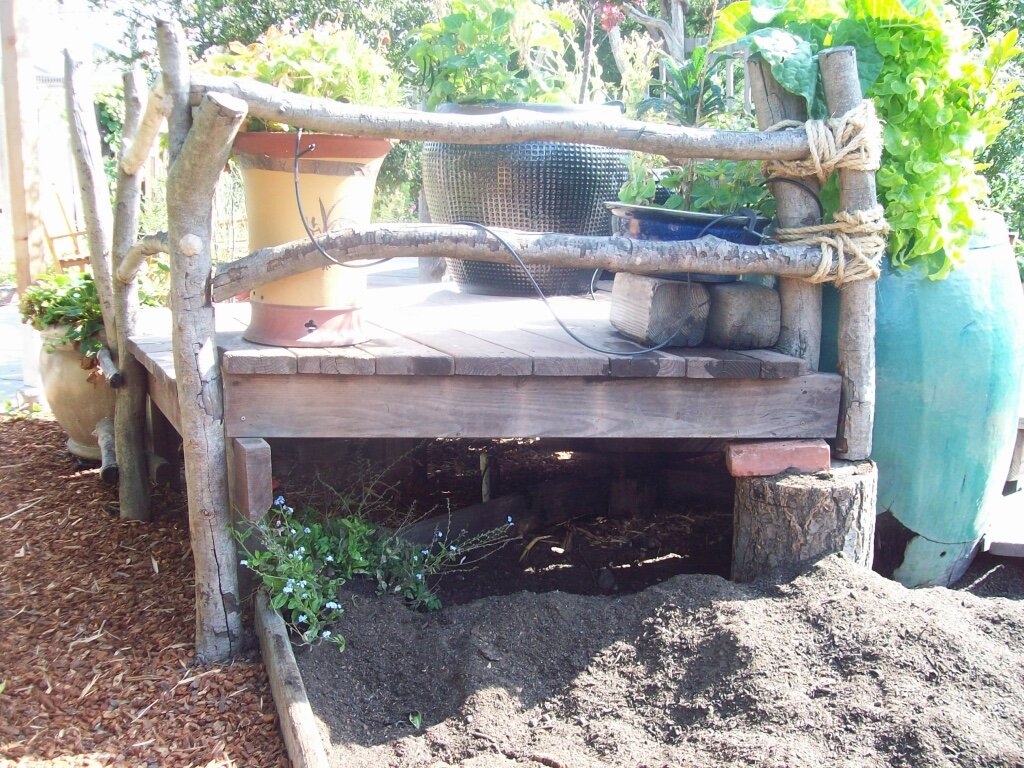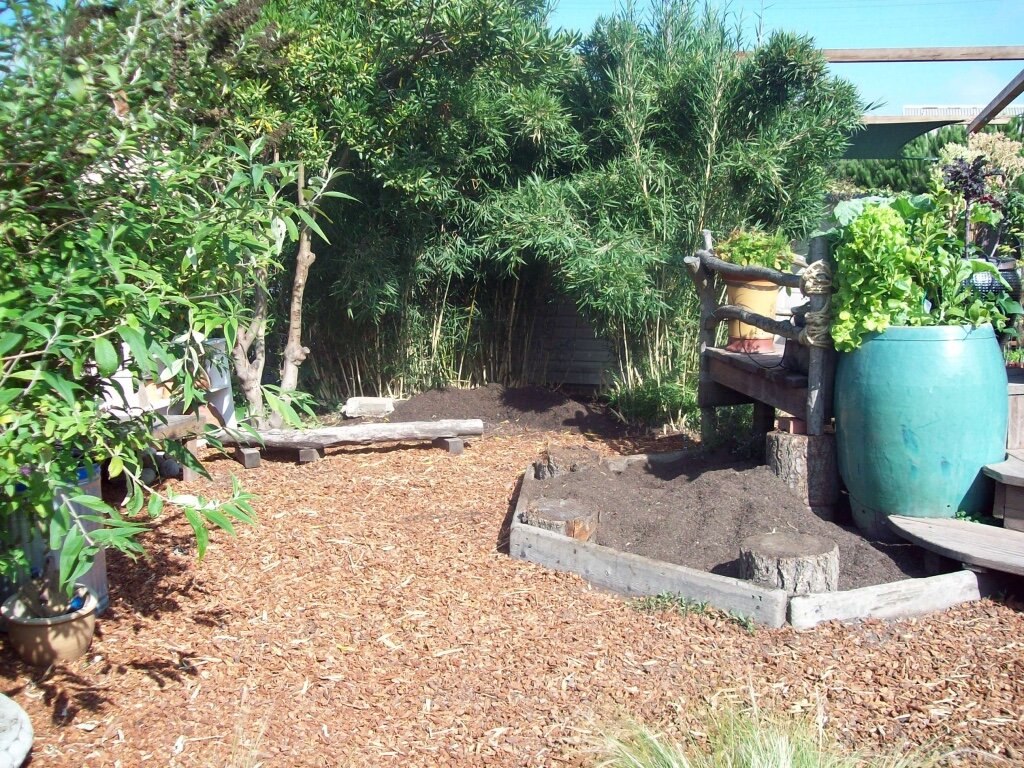Dirt Box
Sandboxes are so common; here’s an idea for a dirt box that’s great for kids’ explorations and can be used as a place to store mulch, soil amendments, and potting materials to boot! This dirt box was built as an extension from behind a fanciful, multi-layered “pot deck,” meant for the sensory and physical enjoyment of preschool children ages two through five.
Materials
Container
Soil
Various Supplies, as desired
methods
Use real tools meant for grown-ups, as children’s tools made of plastic will not be usable as expected and will break easily.
The soil I used is from American Soil and Stone. I am a dirt geek and loved shopping there! Here is a link to their site: http://www.americansoil.com/
When purchasing soil for the dirt box I took several factors into account. The geology of the site is first. Berkeley, California’s has a heavy concentration of clay. To help that break up and aerate the soil I liked to include a mix with lava rocks. Next comes the intention of the soil. It is for play, for mulching/side dressing, and for planting. For all these reasons I liked to choose something that had both high and low speed decomposition rates, such as chicken manure (high speed) and rice hulls (low speed and also great for aerating the soil). Furthermore, stickiness is a factor. Parents and teachers alike never complained of their children tracking too much mud indoors as the soil blends I used were generally not very sticky. But that doesn't make for the simplest of mud pies, either, so if you want something stickier you would probably choose something with less soil aerating properties and a faster decomposition rate/high organic matter.
Your local soil store probably has their own mixes. From American Soil I always chose a 1/2 and 1/2 blend. 1/2 was always Walt Whitman. The other 1/2 depended on what I thought the garden's current needs were. For example, I got 1/2 Clod Breaker to attempt to alleviate some summertime soil crusting (perceived appearance) issues. I once got soil that I thought was a little too sticky/tacky but that might be better for mud pie/home use which was made up of 1/2 WonderGrow. In general 1/2 Multipurpose is always great. Here is a link to descriptions of all these products: http://www.americansoil.com/amendments.html
When the soil gets tamped down, take picks and/or shovels and break it up, all the way down to the bottom. It’s fun!
See below for some pictures of what the dirt box looked like new and old, in use and while kids were away throughout the seasons.
A lot of people are surprisingly afraid to let children go barefoot. Please keep this fear to yourself and let kids go barefoot if they want!
At various times the fence had vines growing through it, too. Thunbergia was beautiful but died back every winter. Passion vine was beautiful and attracted gulf fritillaries, but was constantly overgrown. I think vines are great if you’re not the person who needs to maintain them.
We wove willow branches and grasses into the fence to help break up the view of the parking lot. It did look a lot more amazing after they painted the building the color you see below, which really highlighted the green leaves in the garden. Those neighbors back there were truly amazing… Tomas Sport Tuning became my most trusted mechanic ever and would let me walk through the back door with kids looking to learn more about auto repair, and another neighbor would regularly loan one of the groups his dog for a couple hours of play. We’d also rescue earthworms after it rained, returning them to soil so they wouldn’t dry up. Being a part of this neighborhood was so fun!
So many experiments with different plants over the years! Speckled lettuce, chocolate mint, and dinosaur and walking stick kale were kid favorites.
Kids learn how to use tools properly when they’re provided with real, quality tools. When play was this “dense,” one safety rule was that the children shouldn’t raise the tools above their heads, which would’ve added a lot of force to an unintended blow.
Let them play! Bodies and clothes are washable!
This is a picture from when the dirt box was in newer condition. It is very hard to keep the look of wood chips on the outside and dirt on the inside if aesthetics is what you are looking for. Nearby are a low table and shelving that weren’t good for indoor classroom use anymore, along with a “balance beam” made from a tree limb.
Over time, the materials wore away. Some of it was simply because it was exposed to the weather over the years and used by 100 preschoolers/week. Surprisingly destructive were roly polies, which ate away at the wood at ground level, along with little fences we built and little seedlings we tried to sprout. Bark around tree rounds fell off naturally but also gave a satisfactory feeling to those who wanted to pick it off with their hands or pry it off with shovel blades, resulting in spaces between the tree rounds and the dirt box they were intended for as the inside “corners.” On the parts of the structure above, I lashed the wood together after it could no longer hold nails. It would be great if handy-people could be utilized to help with upkeep as necessary. Forget-me-nots volunteered in the soil!
Shovels were wrapped with blue plastic tape to match the basket and trash can wrapped in the same material to give a hint as to where those materials should be stored. I drilled holes in the bottom of the trash can so it wouldn’t collect water.
I kept a supply of pots nearby, which children were free to use for building, potting, or any sort of play they desired. They were all reclaimed, and it didn’t matter if they broke.
It was really helpful to have a hose nearby, both for watering the garden, cleaning things off, and making mud as necessary. Drought is a constant part of the California ecosystem, so children were encouraged to use water resourcefully. That was built into this system by having a drinking faucet installed so children could drink at will but also needed to be actively involved if they wanted to use it for play by having to have their hand on the handle. Same with the hose; if it was turned on, any users would need to use the nozzle actively by pulling the trigger. If you look at the hose bib and pots, you will also notice that I installed a drip system. That way we could save water and have plants watered while on vacation! A tube went under the soil between the hose bib and the pot deck.
Part of clean-up was turning pots and buckets upside down so they didn’t collect rainwater, which mosquitos would breed in. Storing everything against the back fence made for clear pathways. The nearby concrete birdbath was filled with mud purposefully so butterflies to drink mineralized water, known as puddling.
That big, beautiful pot was empty at one point, and much taller than most of the preschoolers. It was really fun to climb into, and sometimes I would do it, too, and pop out to surprise everybody! I think that hole got knocked out by a shovel at one point, so we planted a lime tree in it and were good to go! As you can see, the tree rounds on the “corners” are wearing down, and one leg of the “pot deck” completely decomposed. I put tree rounds underneath to help support the deck. I let the kids drill holes into those tree rounds and we observed native bees enter to lay their eggs!
For work parties, I’d have new soil and/or wood chips delivered. The soil would be used as mulch and for potting, while the wood chips were spread along the pathways. Both materials always spilled one into the other, and in this picture it’s wintertime and we needed more wood chips! Wood chips do float on water, however. This particular mix is one of the “muddier” ones, as the rainwater is puddling on top rather than soaking in.
The “tree experiment” was an area we protected with some donated bricks to help protect a volunteer plant we thought may be a tree. I think only weeds ended up growing in that space. The structure with the arch doorway in the rear is a “rocket ship” that was donated and at this point its shiny roof had fallen apart. It worked great as a little play house!
A little bamboo patch behind the “rocket ship” provided hiding places and a “jail,” and we could also cut it down for various building projects such as fences and arches for vines over raised beds. Tearing off the leafy branches was great for developing hand strength and getting out some strong energy!
My attempts at repair. The drip systems were great, but did need constant upkeep with so much play in the area; the hoses would readily get ripped out!
I consider a little red wagon to be essential equipment.
When this child first came to the garden, she’d tell me she wanted to be a model when she grew up, and took great pains to avoid getting any dirt on herself. After some time of weekly garden visits she was playing with her friends, finally letting herself be free, and I saw her laying on her back wrestling around with her buddies. Knowing her and that the result would not be harmful, I gleefully screamed and pointed out that her back was covered in dirt. She got up, screamed, and inspected herself in a mirror screwed into the fence at kid level. She never went back to being a clean kid again, and when I saw her mom a couple years later she told me that her kid was still loving muddy play. Success!!!
By Heather Taylor, teachoutside@gmail.com. You are welcome to share all materials with credit to her.






















